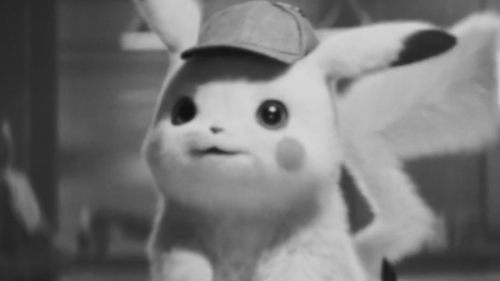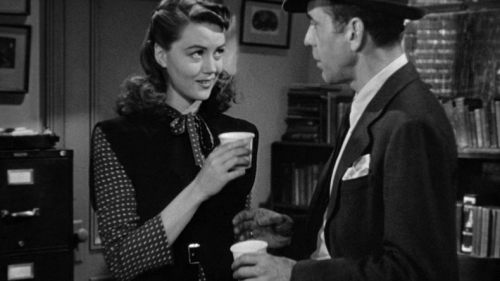Bogart By Gaslight: IN A LONELY PLACE At 70
With the end of the Golden Age of Hollywood in sight, 1950 was a banner year for introspective movies exploring the murkier side of show business and the corrosive effects it can have upon its players. SUNSET BOULEVARD and ALL ABOUT EVE would do battle come awards season, but first out of the gate in this cycle was IN A LONELY PLACE.
Humphrey Bogart stars as volatile struggling screenwriter Dixon Steele, who’s awoken one morning by his war buddy turned Beverly Hills cop Brub Nicolai and taken down to the station: the hat-check girl from Hollywood hangout Paul’s has been murdered and Steele was the last person seen with her.
Noir clichés would have Steele uncover a conspiracy that inspires his comeback masterpiece as he seeks to prove his innocence, but this film isn’t interested in solving the crime: once Steele’s neighbour Laurel Gray, played by Gloria Grahame, arrives and tells the cops she saw the girl leave alone, the murder is all but forgotten as IN A LONELY PLACE reveals itself as a study of an abusive relationship.
Steele and Laurel conduct a coded courtship dance using the kind of repartee Bogart was born to trade with self-possessed women like Grahame, lightly contrasting Laurel’s amused caution with the self-effacement Steele uses to disguise an insecurity unexpected in a Bogart character.
This sets up the ambiguities in Steele which rest on Bogart’s ability to play lines full of double meaning exactly midway between contentment and threat. Take Steele’s speech after Laurel expresses her interest in pursuing a relationship: he tells her how she’s the Noir Pixie Dream Girl he’s sought to find, saying, “Now I know your name, where you live, and how you look.” On the page these read as the words of a stalker, but Bogey invests them with romantic yearning and relief.
Then there’s the film’s famous triplet. “I was born when she kissed me. I died when she left me. I lived a few weeks while she loved me.” Steele asks Laurel to repeat these lines he’s come up with for the script he’s writing as if he’s apologising for the fit of rage he just exhibited upon discovering she had spoken to the police again, but she realises he’s testing her loyalty and hesitates at the final phrase’s appeal to a woman’s responsibility for her partner’s emotional wellbeing.
Steele’s disinterest in Laurel’s life beyond its relation to him, the wild drive through the canyons that cries “Look what you made me do”, the manic energy of his whirlwind proposal and his assertion that Laurel need not know his movements: these are all red flags, and it’s only out of fear that she agrees to marry him even while plotting her escape.
In places, it’s as if the actors bleed into their characters. 1920s icon Louise Brooks wrote that Steele’s “pride in his art, his selfishness, his drunkenness, his lack of energy stabbed with lightning strokes of violence, were shared equally by the real Bogart” and Bogey’s wife Lauren Bacall recounted him flying into a sudden terrifying rage aboard their yacht Santana, the name shared with his production company which made IN A LONELY PLACE.
Gloria Grahame’s lifelong attraction to bad boys brought its own turbulence: among her four husbands was IN A LONELY PLACE’s director Nicholas Ray, but so rocky was their relationship, her contract explicitly acknowledged Ray’s absolute right to both control and silence her while on set and prevented her using any feminine wiles against him. Hollywood also got inside her head, her onscreen appearance convincing her to have repeated cosmetic surgeries which would eventually paralyse her upper lip.
The film is full of depictions of men in positions of power exerting control over women. Mildred Atkinson, the murdered hat-check girl, is very aware of the casting-couch implications of going home with Steele but he uses his industry clout to persuade her: the flowers he later sends acknowledge her purity. Steele’s sometime lover Frances Randolph, who refused to press charges after he beat her up, flirts with him at the bar but is rebuffed with an implication that he’s a changed man, even though he’s just assaulted a loudmouth director. The police also get in on the act: still suspecting Steele, they use his record of violence to persuade Laurel she should change her testimony.
Brub Nicolai also scoffs at his wife Sylvia’s study of psychology. She contends there’s something wrong with Steele after he has them act out his imagining of Mildred’s murder, Bogey’s face animated in a slash of noir eye lighting, but Brub insists her educated opinion is no substitute for his experience of Steele’s mental superiority.
Such unquestioned defence of Steele rings a set of alarm bells all too familiar in 2020. Besides the withdrawn complaint from a producer whose jaw Steele broke and the cone of silence surrounding his bar brawls, he’s surrounded by enablers, not least his agent of 20 years, Mel Lippmann. At all costs Mel keeps the work coming, suppressing his fear of Steele by protecting and cleaning up after him.
Steele never openly denies that he murdered Mildred, but his behaviour convinces Laurel that he could have and that’s enough: she doesn’t want to live in fear, even if leaving means living in a lonely place. When he discovers her plan, Steele cannot be placated by appeals of love and loyalty, but at the very moment she’s about to become one more woman sacrificed to emotionally inarticulate machismo her life is spared by another man’s confession.
For their love, though, the message Mildred’s boyfriend has admitted to her killing comes too late. “Man wants to apologise to you,” says Steele as he hands Laurel the phone and leaves, a final line dripping with multiple meanings.
As Laurel watches Steele trudge off to his own lonely place she claims his words for her own with a finality that refuses to be held liable for his psychopathy. “I lived a few weeks while you loved me.”



